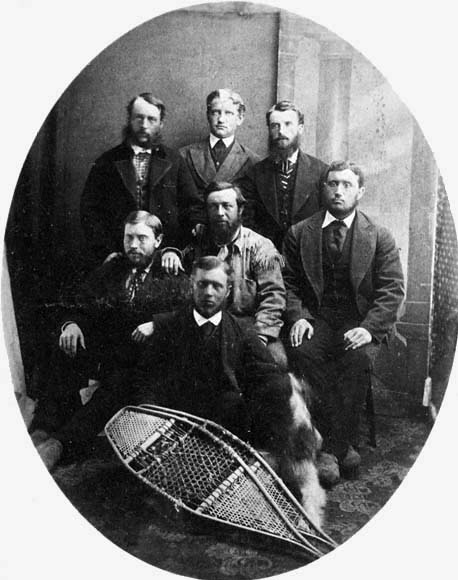

|
Canadian Pacific Railway survey engineers - 1872 Photographer unknown. |
16 March 2011
Part Two: The Railroad That Could Have Been
More notes from the diary of a railway explorer.
My previous column left wood ranger Duncan Macdonald tramping the hills of northeastern Parry Sound District in January 1876, exploring for a route for the
transcontinental Canadian Pacific Railway.
Throughout January and February the survey crew probed eastward, moving camp every few miles (as official "explorer" in the 33-man crew, it was
Macdonald's job to locate campsites in addition to his chief responsibility, snowshoeing ahead of the surveyors locating the best route).
Disappointment and hardship weigh down Macdonald's daily diary entries: "Bulling among the ridges, cannot get low enough grades... One bag of flour
and one bag of hardtack is all the grub in camp... Broke through the ice and got wet to the knees, got one of my toes frozen before I got into camp."
But camp life also had its lighter moments.
Occasionally, a dog team brought in welcome mail, once including a letter from Belle George of Parry Sound, the woman Macdonald would marry that fall.
Sunday was a day of rest, a chance to mend snowshoes or go fishing.
One Sunday, fishermen brought back 30 pounds of speckled trout from a lake tributary to the South River, and weighing up to four pounds apiece.
Another time, when fresh moose tracks were encountered, crew chief William Murdoch and the camp commissariat went hunting "but didn't get a shot."
The winter was remarkably accident-free, and employee relations seem to have been smooth, with one exception.
On the morning of 4 Feb 1876, transit man F.S. Gamble caused "a commotion in camp" by summarily dismissing two axemen, named Currie and Barber,
"because they were late on the work."
The fired pair returned to camp at noon asking to see the boss.
Murdoch apparently overruled Gamble, for the men appear in the diary three days later "clearing the top of Mount Haycock for [astronomical]
observations."
When word reached camp that the mother of axeman E.J. Sirett and dog picket A. Sirett, of Rosseau, was dying, the crew worked short-handed for two weeks.
(Probably these were sons of Mr. and Mrs. Ebenezer Sirett of Ashdown, at the junction of the Nipissing and Parry Sound roads, reputedly the first homesteaders
to settle north of Lake Rosseau.)
On 10 Feb 1876, the crew planted a terminus monument somewhere east of present day Trout Creek and near the west boundary of Algonquin Park.
This apparently fulfilled Murdoch's assignment, distance wise, but two weeks later the crew was still retracing its steps seeking easier grades on the route
already laid out.
Difficulty and discouragement continued to dog them.
On 23 Feb 1876, Macdonald wrote, "Run a mile and backed up. Things looking blue... Smoking tobacco about gone, peas all gone."
Then, next day, a bombshell: "Sirett in with the mail. Orders to disband, news of disappointment and news of joy to some."
Abruptly, the plug had been pulled on surveying for the Georgian Bay Branch of the CPR.
Further instructions ordered "all hands to proceed to the Nipissing Road to be discharged," and 3 Mar 1876 found everyone at the Depot
"demoralized, waiting for teams to take us to Rosseau."
On a cheerier note, they managed that day to procure a bushel of potatoes, "a treat for supper."
A more potent treat followed four days later when, on the eve of their leaving for Rosseau, A.A. Wright, the Depot clerk, "gave a Hogwash banquet at
midnight, and the howl from the camp is a crazy and drunken echo".
Earlier that day, survey crew number 2 under engineer H.D. Lumsden, who had surveyed west toward the French River, left for Rosseau "drunk as owls."
Macdonald and company left the Depot on foot (a hired sleigh carried their gear) at nine a.m. on 8 Mar 1876, and in the evening of the following day they
bedded down in the comfort of William H. Pratt's well-appointed hotel in Rosseau.
Macdonald might then have caught the next Bracebridge-Parry Sound stage, but he was designated to pay off the 22 labourers in the crew, and the expected cash
had yet to arrive.
Six days later, all hands were "still bumming around" the hotel, where "loafing is about played out."
A dog picket dispatched to Gravenhurst for the money returned at last, and on 15 Mar 1876 "All the working men left... partly paid off."
The next day, after nearly 3 1/2 months in the bush, Macdonald came home to find "all the old roosters sound in Parry Sound."
Whether plans for the Georgian Bay Branch were abandoned at this point, or somewhat later, is unclear.
Whatever the case, the wave of agricultural settlers that was even now advancing up the Nipissing and Great North colonization roads, eventually saw their
dream of railway service evaporate.
Just eight days after getting home, Duncan Macdonald left to return to "Trout Lake," the fishing hole discovered on the survey.
Apparently this was in response to a letter that he received from Murdoch while waiting for money at Rosseau, requesting that he procure a quantity of trout
for some upcoming event.
This time, Macdonald went on foot via Dunchurch to Magnetawan and on up the Nipissing Road, then east by dog team to the lake.
It took 10 days just to get there and another week to return.
And, like the railway survey, it was all a wasted effort, for the fish weren't biting.
John Macfie.

|

